My SciELO
Services on Demand
Article
Indicators
-
 Cited by SciELO
Cited by SciELO
Related links
-
 Similars in
SciELO
Similars in
SciELO
Share
Podium. Revista de Ciencia y Tecnología en la Cultura Física
On-line version ISSN 1996-2452
Rev Podium vol.16 no.1 Pinar del Río Jan.-Apr. 2021 Epub Apr 20, 2021
Original article
The ratio and its relation with the motor capacities in the Judo women athletes of Camagüey
1Universidad de Camagüey "Ignacio Agramonte". Facultad de Cultura Física. Camagüey, Cuba.
In sports training, performance evaluations are made using the results of tests in which the global manifestation of the phenotype of the infants is measured, without discriminating the influence that each of the elements that intervene in it has, such is the case of female Judo in Camagüey, since the relationship between the ratio of the fingers and the motor capacities is unknown. That's why the objective is to determine the relationship between the ratio of the fingers with the motor skills in the school Judo women athletes of Camaguey. It was developed a transversal research in which the theoretical methods that constitute the logical processes of thought and empirical fundamentally the measurement are used, as well as the descriptive statistics by means of the measurement of average central tendency: mean, standard deviation, maximum and minimum; as well as inferential statistics, determining if there is correlation between the ratio and the capacities, for which Pearson's correlation coefficient is applied. Concluding that in the studied athletes an inverse relation was found between the ratio of the right hand and the motor capacities strength and speed, not being strong. The relationship found between the capacities and the ratio is not linear.
Key words: Fingers’ ratio; sport training; motor capacities.
INTRODUCTION
Attitudes that are favorable to the practice of sports are intimately associated with heredity and the environment in which the child develops. Zatsiorski, (1989) explains that the properties and qualities of man that are stable enough to influence the success of a certain activity are developed on the basis of the dialectic unity of congenital and acquired properties.
The discrimination of the influence of the genetic component within the context of the phenotype is important because it would allow the establishment of the true ceiling in terms of the functional possibilities of the athlete, which is a step forward to achieve greater efficiency in the preparation process of the athlete because it would allow the early discarding of future sports "talents" that will never really achieve such a category and at the same time identify the true sports talent. Thus, it is recognized and accepted by the scientific community, the criterion that the development of skills has a hereditary basis, determined by all the genes that the individual receives from parents (genotype). For the selection of a possible talent, the starting point is the model characteristics and the prognosis of sports aptitude, and within them the compensable and non-compensable indicators must be evaluated Tamarit, Muñoz and Mesa, (2011).
The model characteristics or indicators are very often categorized as conservative or non-compensable (or not trainable) which are genetically predetermined, inherited, and not conservative or compensable (which vary under the training effect). Ultimately, in selection it is important to be guided by the conservative, non-compensable indicators.
The sciences applied to sports make great efforts to this end, which is why, at present, those particularities that are little modified by sports training are studied in depth, making it possible to predict certain characteristics that have a strong influence on sports performance. These variables are called biological markers.
Biological markers are those particularities that cannot be modified by sports training, being the result of the relationship established between structure and function. From this criterion it can be inferred that the human organism performs very particular functions from the structures of the different systems, and in this process the endocrine system has a decisive incidence, which from the glands and hormones directly influences the formation of the structures and the functioning of the body, such is the case of the sexual hormones Tamarit, Muñoz, Mesa, (2011).
Sex hormones in the male sex and estrogens in the female sex will mark the development of future life. These hormones are synthesized from cholesterol following a common pathway. Androgens, testosterone and androstenedione are precursors of estrogen synthesis in the testes, ovaries, adrenals placenta, Izquierdo (2010).
In the literature, there is evidence that sex steroids during the organizational period play an important role in the manifestation of sexual differences in behavior; for example, it has been reported that in both men and women, high levels of androgens during the critical period of prenatal development are associated with the manifestation of male behavior Inozemtseva, (2011).
In this process there are moments of maximum coordination in stages of very limited duration, in which a certain influence that can be from another area of the body (hormones), produce a specific reaction. These moments, also called critical periods, are very evident in the prenatal stage and especially in the first three months when the general pattern of the human body is structured.
Testosterone is an anabolic-protein hormone par excellence, it helps form proteins, promotes the development of muscle mass, has an action on the bone marrow (hematopoiesis), acts on the bone mass promoting bone formation, has an action on the metabolism of carbohydrates, lipids and prostatic tissue, acts in the physical transformation from child to man, in the maturation of the reproductive system and in the development of its bone and muscle mass as facial and body hair growth (differentiation between male and female) Neave, Laing, Fink and Manning, (2003).
As specified in the previous paragraph, testosterone is involved in bone formation, and in this respect it is considered to have an incidence on the length of the fingers that is established in intrauterine life and is not significantly modified during life. For this reason, it has been suggested that intrasexual competition between men has been an important selection pressure in the evolution of sexual differences in prenatal testosterone concentrations. In this regard, a study carried out in the rowing modality supports the theory of the D2/D4 ratio as a predictor of sports ability, implying greater aerobic capacity and strength, showing that the D2/D4 ratio significantly correlates with performance levels in a sports discipline that requires greater energy contribution from the aerobic and anaerobic systems; this suggests that there may be a link between exposure to androgens and the precursors required for the generation of muscle strength and good development of the cardiovascular system in men, López, (2016).
Many of the skills employed in sports are the same as those required for the wrestling and competition among men, so the relationship between the 2D:4D index and better sports practice is best interpreted within the evolving conceptual framework of intra-sexual competition. Preliminary evidence suggests that intersex variability in the relationship between the length of the second (index) and fourth fingers (2D:4D), as an indirect marker of prenatal androgen levels, may have a strong and consistent relationship with implicit measures that correspond to explicit measures of personality traits Martin and Stefan, (2009).
Dr. Manning argues that men tend to have a longer fourth digit due to a high concentration of testosterone during the development of the prenatal stage, which would influence future behaviors, morphological characteristics and physical abilities. While women normally have both fingers of similar size.
During the gestation period, the ring fingers possess a greater number of receptors for the testosterone hormone. The ratio of the second (index) finger and the fourth (ring) finger illustrates the number of male hormones, primarily testosterone, that a person is exposed to in the mother's womb (Manning et al., 2007; Fink et al., 2003; Fink et al., 2004).
The 2D:4D finger ratio expresses sexual dimorphism: while the second finger is typically shorter for men, the difference in length between the two fingers is higher for men than for women (Manning et al., 2007; Manning et al., 2014). This increased exposure to prenatal testosterone probably promotes performance in sports. It was shown that the lower proportion of the finger (indicating that prenatal androgen exposure was high) indicates good sports performance in soccer, surfing, sprinting, endurance, hand strength, rowing, swimming, tennis, among others (Manning et al., 2007; Islam & Kundu, 2019; Manning & Hill, 2009; Hone & McCullough, 2012; Longman et al., 2011; Sudhakar et al., 2014; Sudhakar et al., 2013; Hsu et al., 2015; Kim & Kim, 2016; Islam & Kundu, 2020).
Several studies claim that the low digital ratio of the second and fourth fingers is due to the hormone prenatal testosterone, associated with male traits. They also recommend that the 2D:4D ratio be a feasible indicator for the success rate of sports (Islam & Kundu, 2020).
Many authors associate the ratio (index finger and ring finger) as a biological marker for fetal exposure to testosterone, because this exposure, especially from the ninth week of gestation, will determine future physical, physiological and psychological characteristics. Therefore, if during pregnancy the conditions and state of the mother are prone to a higher production of testosterone this will have a direct impact on the baby.
However, the effect that the genetic component has on the sporting result is not used systematically in the training process, but rather in tests that measure physical and sometimes functional indicators, that is, the overall manifestation of the phenotype of the subject, without discriminating between the influence of each of the elements involved. However, genetically predetermined indicators such as the ratio of the fingers are not used, so the profile of school athletes and their relationship with motor skills is unknown. From this situation, it is the purpose of the study to determine the profile of the ratio of the fingers of the hands and its relationship with motor skills in school Judo female athletes of Camaguey during the academic year 2013-2014.
MATERIAL AND METHODS
The research process was carried out during the 2013-2104 school year, using the cross-sectional field research model. Theoretical methods are used that constitute the logical processes of thought that make it possible to ascend in the spiral of knowledge, moving from living contemplation to abstract thought and from there to scientific practice. The methodical approach conceived to concretize the research process is framed in five moments that will be described below.
The factual-perceptual analysis of the problem under study is developed, determining its external manifestations. The phasic approach made it possible to conclude in a first approximation that in the training process the trainers do not use the ratio of the index and ring fingers of the hands as a non-labile indicator with sports training. To carry out this factual-perceptual analysis, the fundamental methods and techniques used are analysis and synthesis, induction-deduction, observation, document review, and unstructured interviews.
From the results of the factual analysis, the process of determining the sport under investigation and the population to be studied, the authors assumed the incidence that Judo has in the Olympic medal. The studied population is integrated by the 15 school female athletes (eleven in ages between 12-14 years; four of 15-16 years) that constitute the enrollment of the Integral Sport School (EIDE) and that constitute the high provincial performance.
After selecting the population, the anthropometric characteristics of the index and ring fingers are determined. To carry out this step of the research process, measurement is used as a fundamental scientific method, which was developed during the month of March 2014, when Judo women athletes are found in the special varied mesocycle.
To achieve the measurement standardization process, the authors deployed the following method:
The measurements were always taken in the morning session.
All measurements were taken on Wednesdays.
The measurements were always taken by the same subjects, who in this case are the authors of the research.
The measurements were always taken with the same measuring instrument (Vernier caliper).
To carry out the measurement, the following method is established:
Preparation of the information collection form.
Measurement of the length of the index and ring fingers.
To measure the fingers proceed as follows:
The researcher orients the athlete to open the hand.
The hand is placed in an anthropometric position in the supine position.
The researcher holds the athlete's hand in the position indicated above.
The caliper is placed at the beginning of the finger (fold) and the compass is opened up to the tip, determining the distance that exists and with it the length of each finger.
First the index finger is measured and then the ring finger. It is necessary to make three consecutive measurements on each finger to rule out errors in the measurement. Both hands are measured.
Annotation of the result in the data collection form
After the data related to the length of the fingers is obtained, the ratio of the index and ring fingers is determined, for this the ratio 2D:4D is determined. The mathematical method is used for this purpose. After having determined the ratio of the fingers, the descriptive statistics are used to determine the measure of central tendency: average, as well as the dispersion statistics by means of the standard deviation and the variation coefficient. Once the process of determining the descriptive statistics is completed, the researchers use the techniques of inferential statistics applying Pearson's correlation to assess whether there is a correlation between the ratios of both hands.
By reviewing the evaluation record of the pedagogical tests, the results of the tests applied by the trainers in the last pedagogical test carried out the week before the measurement of the fingers are collected, where a strength-resistance test is carried out which consists of performing the greatest number of tractions on a fixed bar during 30 seconds, translation speed in the distance of 50 meters with flying start, where the time carried out is determined, and resistance in the 1500 meter test. The results are processed by determining the central tendency and dispersion measurements as in the fingers. Pearson's correlation is applied to see if there is a relationship between the ratio of each hand and each of the tests performed.
After having made the descriptive and inferential statistics, the anthropometric profiles for both sexes are evaluated, as well as the relationship between the ratio and the biological demands of the sport under study.
RESULTS
After processing the data obtained, it was necessary to present the results in order to determine the profile of the ratio of the fingers of the hands in their relation to the motor capacities necessary for Judo. For this purpose, the analysis was carried out taking into account the ages.
Table 1 - Individual finger ratio and motor test results of Judo female athletes aged 12-14
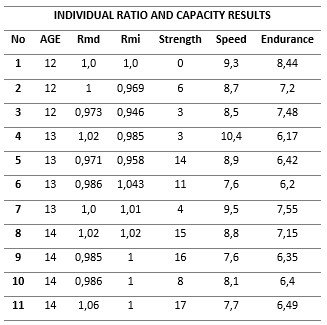
Source: SPSS Data Processing Statistical Package, version 15.00. Legend: Rmd: right hand ratio; Rmi: left hand ratio.
The table reflects the results of the ratio profile of the fingers of both hands, in the ages between 12 and 14 years. In this respect, six athletes have the ratio of the right hand equal to or greater than one; while in the case of the left hand, seven have this profile. It is important to highlight in this respect that only four coincide in both hands with ratios equal to or higher than one; moreover, only in the case of athlete 11 who has a ratio with these characteristics shows high results in all the tests, while in the remaining judo female athletes with high results in the tests one of the two hands has a ratio lower than one (Table 1).
As far as the relation with the capacities, it is observed that the athletes with results of the force superior to ten possess in one of their hands inferior ratios to one, which has been characteristic of the values in this investigation (Table 2).
Table 2 - Results of the descriptive statistics of the ratio and the capacities of the Judo female athletes with ages between 12 and 14 years
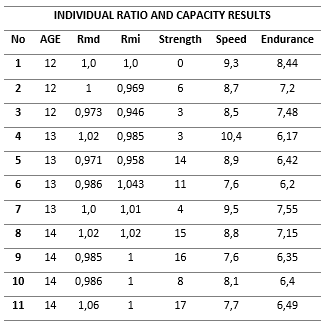
Source: SPSS Data Processing Statistical Package, version 15.00. Legend: Rmd: right hand ratio; Rmi: left hand ratio.
The results of the descriptive statistics shown in table two indicate that both hands do not have the same ratio. Note that the standard deviation is low in almost all variables except force, which indicates that in this there is dispersion of the results of the group under study.
Table 3 - Results of the correlation between the ratio of both hands of Judo female athletes aged between 12 and 14
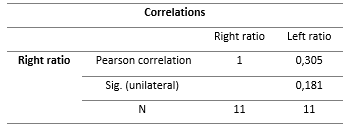
Source: SPSS Data Processing Statistical Package, version 15.00.
As shown in the table above, there is no strong correlation between the ratio of both hands, which indicates that it is necessary to determine which hand to use to make the selection of the Judo female athletes (Table 3).
Table 4 - Results of the correlation between the ratio of the right hand and the capacities of the Judo female athletes with ages between 12 and 14 years

Source: SPSS Data Processing Statistical Package, version 15.00.
Table 5 - Results of the correlation between the ratio of the left hand and the capacities of the Judo female athletes with ages between 12 and 14 years
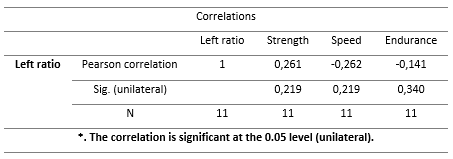
Source: SPSS Data Processing Statistical Package, version 15.00.
The results of the correlation between the ratio of hands to motor skills (Table 4) and (Table 5) indicate that even when there is a correlation between these variables, it cannot be considered as a strong linear correlation. This does not mean that there is not a strong relationship of another type.
Table 6 - Individual finger ratio and motor test results of Judo female athletes aged 15-16
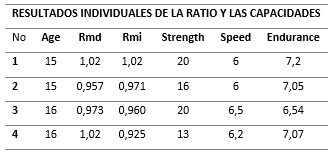
Source: SPSS Data Processing Statistical Package, version 15.00 Legend: Rmd: right hand ratio; Rmi: left hand ratio.
As for the individual results of the females with ages between 15 and 16 years old (Table 6), it is observed that there is coincidence with the age before analyzed where the profile of the ratio of the right hand tends to be equal to one, while on the left it is not that way. It is necessary to state that the Judo female athletes with the best results in strength, speed and resistance are those that have a right hand ratio with this value, although the left hand one is lower.
Table 7 - Results of the descriptive statistics of the ratio and the capacities of the Judo female athletes with ages between 15 and 16 years
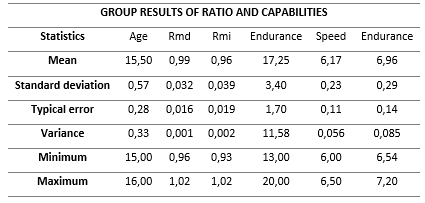
Source: SPSS Data Processing Statistical Package, version 15.00. Legend: Rmd: right hand ratio; Rmi: left hand ratio.
The descriptive results of these ages show that in both hands the ratio is less than one, although the right hand is very close to that value. Note that the standard deviation of the variables is low except for the strength.
Table 8 - Results of the correlation between the ratio of the right hand and the capacities of the Judo female athletes with ages between 15 and 16 years

Source: SPSS Data Processing Statistical Package, version 15.00.
It is shown that there is an inverse correlation between the strength, speed and ratio of the right hand, although it is not significantly strong, it is not linear it is considered as good because it indicates that the lower the result of the hand ratio the better the results obtained in the mentioned variables (Table 8).
Table 9 - Results of the correlation between the ratio of the left hand and the capacities of the Judo female athletes with ages between 15 and 16 years
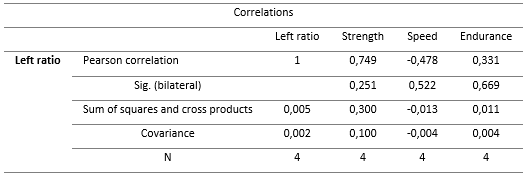
Source: SPSS Data Processing Statistical Package, version 15.00.
It is observed that there is no strong line relationship between the results of the hand ratio and the motor skills studied (Table 9).
Table 10 - General results of the descriptive statistics of the ratio of the Judo female athletes under study without taking into account the age
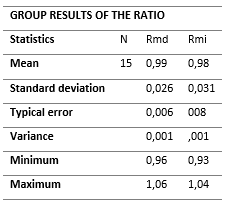
Source: SPSS Data Processing Statistical Package, version 15.00. Legend: Rmd: right hand ration; Rmi: left hand ratio.
The descriptive statistics of all the studied group that is collected in table ten, allows to appreciate that in general the studied group has a ratio close to one (Table 10).
DISCUSSION
The electronic magazines and other publications consulted do not report results related to the association between the ratio of fingers and sport performance in female athletes, in the ages under study in Cuba. The results obtained in the ages from 12 to 15 (Table 1) show that the ratio length does not depend on girls' age, since it is appreciated that 15-year-old athletes have a ratio equal to one than 12-year-old athletes. As for the relationship with abilities, it is observed in agreement with the literature consulted that athletes with strength results over ten have ratios lower than one in one of their hands. This indicates that the girls have been exposed to testosterone during their fetal life. When relating speed and strength, the same thing happens as with strength, with the ratio ranging from 0.97 to 0.98. It should be noted that the results obtained are not characteristic of conventional females where it has been observed that in women the index and ring fingers are almost the same length López, (2016). Therefore, it is agreed with the consulted authors in that this low relation D2/D4 would be related to the performance and success in the sport, so the D2/D4 could be used as a predictor of the sport success Hönekopp, Manning & Müller, (2006).
The expressed is sustained when assuming Lopez who raises that the investigations take the value of 0.98±0.03mm as a cut-off point to determine the prenatal exposure to testosterone. The values in D2/D4 < 0,98±0,03mm indicate a high prenatal exposure to testosterone and the values in D2/D4 > 0,98±0,03mm indicate low exposure López, (2016).
As for the group results of these ages (Table 2), it can be seen that the ratio profile of the right hand of the Judo female athletes with ages between 12 and 15 years is equal to a characteristic profile of the women. While in the left hand we obtain average values characteristic of the male sex being these inferior to one. This particularity makes it possible to infer that the hand with the lowest ratio is the one that should be used, and that the females with these particularities should be selected.
As shown in Table 7, the ratio profile of the fingers of both hands is less than one, which may be indicative of greater exposure to testosterone in intrauterine life.
As can be seen in Table 10, the ratio of the Judo female athletes studied without taking into account their age is less than one in both hands, but in the right hand it is not significant since it does not coincide with the values assumed as reference. This indicates that the group in general does not possess athletic characteristics, which makes it possible to infer that one should select those that present the greatest vestiges of testosterone exposure during fetal life.
The ratio of the fingers does not depend on the age of the girls since, as can be seen, the ratio of the older athletes to the younger ones is equal to one.
It is observed that female athletes with the best results in strength, speed and resistance have ratios of less than one in one of their hands, which has been characteristic of the values in this research, coinciding with the literature consulted, although no strong correlation was found between the ratio and the capacities from the statistical point of view.
The ratio profile of the right hand of the school Judo female athletes is equal to one, characteristic of the girls; while in the left hand average values are obtained characteristic of the male sex being these inferior to one. In juvenile girls the ratio profile of the fingers of both hands is less than one, which may be indicative of greater exposure to testosterone in intrauterine life.
The results obtained at the ages of 12 to 14 years show that there is no strong linear correlation between the ratio and the abilities studied; while at 15-16 years there is an inverse correlation between the strength, speed and ratio of the right hand, although it is not significantly strong and therefore, although it is not linear it is considered as good because it indicates that the lower the result of the ratio of the hand the better the results obtained in the variables mentioned.
REFERENCIAS BIBLIOGRÁFICAS
Fink, B., Neave, N., & Manning, J. T. (2003). Second to fourth digit ratio, body mass index, waist-to-hip ratio, and waist-to-chest ratio: Their relationships in heterosexual men and women. Annals of Human Biology, 30(6), 728-738. https://doi.org/10.1080/03014460310001620153 [ Links ]
Fink, Bernhard, Manning, J. T., & Neave, N. (2004). Second to fourth digit ratio and the `big five' personality factors. Personality and Individual Differences, 37(3), 495-503. https://doi.org/10.1016/j.paid.2003.09.018 [ Links ]
Hönekopp, J., T Manning, J., & Müller, C. (2006). Digit ratio (2D:4D) and physicalfitness in males and females: Evidenceforeffects of prenatal androgensonsexuallyselectedtraits. Hormones and Behavior, 49(4), 545-549. https://doi.org/10.1016/j.yhbeh.2005.11.006 [ Links ]
Hone, L. S. E., & McCullough, M. E. (2012). 2D:4D ratios predict hand grip strength (but not hand grip endurance) in men (but not in women). Evolution and Human Behavior, 33(6), 780-789. https://doi.org/10.1016/j.evolhumbehav.2012.07.003 [ Links ]
Izquierdo de la Cruz, R. (2010). Importancia de los genes y las hormonas en la diferenciación sexual. http://fcmjtrigo.sld.cu/materiales/histoembriologia/embriologiaII/mcdrfsex.doc. [ Links ]
Islam, M. S., & Kundu, B. (2019). Digit ratio and soccer. Orthopedics and Sports Medicine: Open Access Journal, 3(1), 227-230. https://doi.org/10.32474/OSMOAJ.2019.03.000154 [ Links ]
Islam, M. S., & Kundu, B. (2020). Soccer Passing Accuracy Differentiates Between High and Low Digit Ratio (2D:4D) Soccer Players. American Journal of Sports Science, 8(3), 49-55. https://doi.org/10.11648/j.ajss.20200803.11 [ Links ]
Islam, M. S., & Kundu, B. (2020). Low digit ratio (2D:4D) and masculine attributes: a critical analysis. International Journal of Research-GRANTHAALAYAH, 8(7), 384-390. https://doi.org/10.29121/granthaalayah.v8.i7.2020.773 [ Links ]
Inozemtseva, O., & Camberos, N. (2011). El Papel de las Hormonas en la Maduración del Sistema Nervioso Central y en el Desarrollo Cognitivo y Conductal. Revista Neuropsicología, Neuropsiquiatría y Neurociencias, 11(1), 173-192. https://dialnet.unirioja.es/servlet/articulo?codigo=3640873 [ Links ]
López, S. (2016). Relación digital D2/D4 y VO2máx en estudiantes universitarios de educación física. Rev.salud.hist.sanid.on-line 98-106. http://revistas.uptc.edu.co/revistas/index.php/shs [ Links ]
Longman, D., Stock, J. T., & Wells, J. C. K. (2011). Digit ratio (2D:4D) and rowing ergometer performance in males and females. American Journal of Physical Anthropology, 144(3), 337-341. https://doi.org/10.1002/ajpa.21407 [ Links ]
Manning, John T., Churchill, A. J. G., & Peters, M. (2007). The effects of sex, ethnicity, and sexual orientation on self-measured digit ratio (2D:4D). Archives of Sexual Behavior, 36(2), 223-233. https://doi.org/10.1007/s10508-007-9171-6 [ Links ]
Manning, J. T., & Hill, M. R. (2009). Digit ratio (2D:4D) and sprinting speed in boys. American Journal of Human Biology: The Official Journal of the Human Biology Council, 21(2), 210-213. https://doi.org/10.1002/ajhb.20855 [ Links ]
Manning, J., Kilduff, L., Cook, C., Crewther, B., & Fink, B. (2014). Digit Ratio (2D:4D): A Biomarker for Prenatal Sex Steroids and Adult Sex Steroids in Challenge Situations. Frontiers in Endocrinology, 5. https://doi.org/10.3389/fendo.2014.00009 [ Links ]
Martínez, A. (1987). Antropología Física: El hombre y su medio. Científico-Técnica. https://books.google.com.cu/books?id=wEwYYAAACAAJ&dq=Antropolog%C3%ADa+F%C3%ADsica:+El+hombre+y+su+medio&hl=es-419&sa=X&redir_esc=y [ Links ]
Neave, N., Laing, S., Fink, B., & Manning, J. T. (2003). Second to four the digit ratio, testosterone and perceived male dominance. Proceedings of the Royal Society B: BiologicalSciences, 270(1529), 2167-2172. https://doi.org/10.1098/rspb.2003.2502 [ Links ]
Tamarit, R.; Muñoz, I. y Mesa, L. (2011). Características dermopapiloscópicas de estudiantes de primer grado de la escuela primaria "Abel Santamaría Cuadrado" del municipio de Camagüey. Revista digital Ciencia y Deportes. 2 (2). http://revistas.reduc.edu.cu/index.php/cienciaydeporte/ [ Links ]
Zatsiorski, V. M. (1989). Metrología Deportiva. Moscú: Planeta. https://books.google.com.cu/books/about/Metrolog%C3%ADa_deportiva.html?id=P45WPQAACAAJ&redir_esc=y [ Links ]
Received: December 11, 2019; Accepted: January 12, 2021











 text in
text in 


